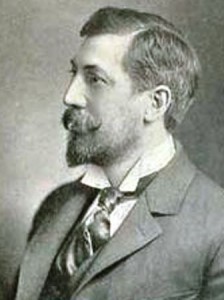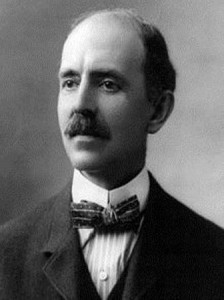» posted on Saturday, July 13th, 2013 by Linda Lou Burton
Three Men And A Quadriga
 Linda Burton posting from Saint Paul, Minnesota – I won’t lie to you. I was way too chicken to walk out on that upper balcony for a picture of the famous Quadriga. I met two nice women who did though, and shared their pictures with me, so I can show you the awesome sight from high atop the capitol building in downtown Saint Paul. I did take the picture of my car out front, so you can get a perspective of everything I want you to see – the location and size of the Quadriga, and the proximity of the two fabulous domed buildings that bookend John Ireland Boulevard in Saint
Linda Burton posting from Saint Paul, Minnesota – I won’t lie to you. I was way too chicken to walk out on that upper balcony for a picture of the famous Quadriga. I met two nice women who did though, and shared their pictures with me, so I can show you the awesome sight from high atop the capitol building in downtown Saint Paul. I did take the picture of my car out front, so you can get a perspective of everything I want you to see – the location and size of the Quadriga, and the proximity of the two fabulous domed buildings that bookend John Ireland Boulevard in Saint 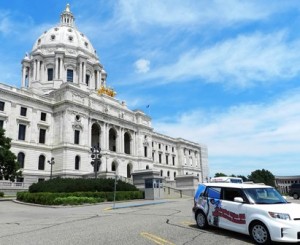 Paul – the State Capitol, which was completed in 1905, and the Cathedral of Saint Paul; construction began on it in 1906. But I’m focusing on the capitol today, and I’ll start with the Quadriga, the shimmery-gold group of sculptural figures named “Progress of the State” perched above the main entrance to the capitol. The grouping consists of a chariot pulled by four horses, and three human figures – two women and a man. The horses represent the classical elements of earth, air, fire and water. The women represent industry and agriculture; together that depicts civilization. The male charioteer represents prosperity; he holds a variation of a Roman Legion standard
Paul – the State Capitol, which was completed in 1905, and the Cathedral of Saint Paul; construction began on it in 1906. But I’m focusing on the capitol today, and I’ll start with the Quadriga, the shimmery-gold group of sculptural figures named “Progress of the State” perched above the main entrance to the capitol. The grouping consists of a chariot pulled by four horses, and three human figures – two women and a man. The horses represent the classical elements of earth, air, fire and water. The women represent industry and agriculture; together that depicts civilization. The male charioteer represents prosperity; he holds a variation of a Roman Legion standard 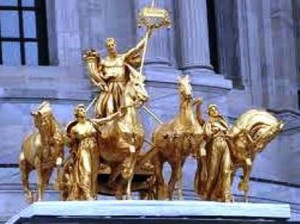 inscribed with the state name Minnesota. The Quadriga is made of copper and gilded in gold, with a few regildings since it first appeared; it was definitely putting on a shine in today’s blazing sun. The quadriga sculptural arrangement goes back over 2000 years to the Roman republic; an emblem of triumph, you’ll find quadrigas on European buildings from Paris to Rome. Sculptors Daniel Chester French and Edward Clark Potter get credit for this one; credit for the capitol goes to Cass Gilbert.
inscribed with the state name Minnesota. The Quadriga is made of copper and gilded in gold, with a few regildings since it first appeared; it was definitely putting on a shine in today’s blazing sun. The quadriga sculptural arrangement goes back over 2000 years to the Roman republic; an emblem of triumph, you’ll find quadrigas on European buildings from Paris to Rome. Sculptors Daniel Chester French and Edward Clark Potter get credit for this one; credit for the capitol goes to Cass Gilbert.
Yes, Cass Gilbert (1859-1934), a Saint Paul resident, who went on to design many other well-known buildings, such as the Woolworth Building in New York, the world’s tallest building at the time it was built in 1913. And he designed the West Virginia state capitol, built between 1924-1932. But he got his feet wet, so to speak, in Saint Paul, where he first established a practice. Many of his Minnesota buildings remain, including residences on Summit Avenue, several churches and office buildings, and of course, the capitol. He was selected as the architect for Minnesota’s third capitol building in 1895 after winning a design competition that included 40 entries. Gilbert was a conservative, who believed architecture should reflect historic traditions, and the established social order.
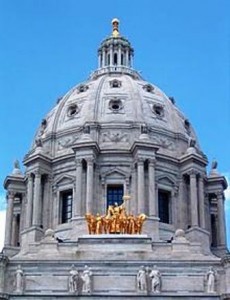 He modeled the Minnesota capitol after Saint Peter’s Basilica in Rome, and its unsupported marble dome is the second largest in the world, after Saint Peter’s. His drawings show that he originally planned a wider drum and, correspondingly, a more massive dome. The smaller dome as built is smaller than Saint Peter’s and has a simplified design; Gilbert knew that Saint Peter’s dome was on the edge of being unstable; it had cracked and had to be reinforced. He had his engineer Gunvald Aus bind the capitol’s brick dome in reinforcing steel bands, and he crowned the paired columns around the drum (which act as buttresses to counter the dome’s weight) with additional stone.
He modeled the Minnesota capitol after Saint Peter’s Basilica in Rome, and its unsupported marble dome is the second largest in the world, after Saint Peter’s. His drawings show that he originally planned a wider drum and, correspondingly, a more massive dome. The smaller dome as built is smaller than Saint Peter’s and has a simplified design; Gilbert knew that Saint Peter’s dome was on the edge of being unstable; it had cracked and had to be reinforced. He had his engineer Gunvald Aus bind the capitol’s brick dome in reinforcing steel bands, and he crowned the paired columns around the drum (which act as buttresses to counter the dome’s weight) with additional stone.
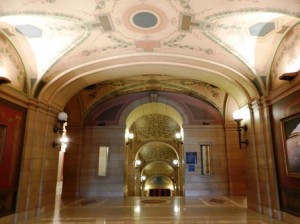 Gilbert not only designed the structure, he supervised its construction and its decoration. “In the old days,” he said, “the architect, painter and sculptor were frequently the same man. There is no reason why they should not be now.” Work began on the building in 1896; it was completed nine years later at a cost of $4.5 million and opened to the public January 2, 1905, one day before the 34th legislature convened. More than 20 types of stone were used in the halls, stairways, and chambers, including limestone from Mankato, which you’ll see on the walls. The vaulted ceilings are decorated with handpainted arabesques and designs of grains and fruits grown in Minnesota.
Gilbert not only designed the structure, he supervised its construction and its decoration. “In the old days,” he said, “the architect, painter and sculptor were frequently the same man. There is no reason why they should not be now.” Work began on the building in 1896; it was completed nine years later at a cost of $4.5 million and opened to the public January 2, 1905, one day before the 34th legislature convened. More than 20 types of stone were used in the halls, stairways, and chambers, including limestone from Mankato, which you’ll see on the walls. The vaulted ceilings are decorated with handpainted arabesques and designs of grains and fruits grown in Minnesota.
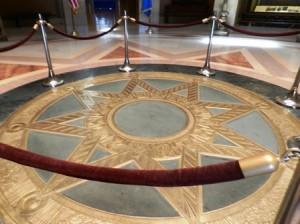 The tour had already started when I arrived; but I caught on with the explanation of the great star in the rotunda floor, “Minnesota is the North Star state,” she said. “It’s also called the Gopher State, and the Land of 10,000 Lakes.” Looking up, we saw a crystal chandelier hanging from the dome; light filtered through the windows above, highlighting the four murals telling the allegorical story of “The Civilization of the Northwest.” Over against the walls glass cases displayed the flags that were carried by Minnesota soldiers in the Civil and
The tour had already started when I arrived; but I caught on with the explanation of the great star in the rotunda floor, “Minnesota is the North Star state,” she said. “It’s also called the Gopher State, and the Land of 10,000 Lakes.” Looking up, we saw a crystal chandelier hanging from the dome; light filtered through the windows above, highlighting the four murals telling the allegorical story of “The Civilization of the Northwest.” Over against the walls glass cases displayed the flags that were carried by Minnesota soldiers in the Civil and 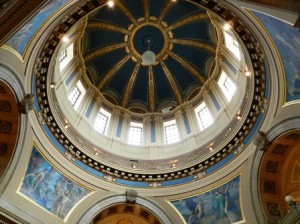 Spanish-American wars. The tour continued down the hall to the Governor’s Reception Room; an ornately decorated, dimly-lit spot filled with historic furniture, including a hand-carved mahogany table designed by none other than Cass Gilbert (do not touch). The walls were covered with six large paintings of scenes from Minnesota history; there is Father Louis Hennepin at the Falls of St Anthony, and the signing of the Treaty of Traverse des Sioux in 1851, where the United States obtained the land that is now most of
Spanish-American wars. The tour continued down the hall to the Governor’s Reception Room; an ornately decorated, dimly-lit spot filled with historic furniture, including a hand-carved mahogany table designed by none other than Cass Gilbert (do not touch). The walls were covered with six large paintings of scenes from Minnesota history; there is Father Louis Hennepin at the Falls of St Anthony, and the signing of the Treaty of Traverse des Sioux in 1851, where the United States obtained the land that is now most of 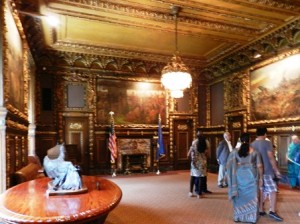 southern Minnesota from the Dakota. The other paintings show Minnesota regiments that fought in the Civil War. “When you’re done looking,” the tour guide said, “I’ll turn off the lights and lock the door.”
southern Minnesota from the Dakota. The other paintings show Minnesota regiments that fought in the Civil War. “When you’re done looking,” the tour guide said, “I’ll turn off the lights and lock the door.”
I eased away from the tour at that point (I won’t lie to you); it’s difficult to get photos in a crowd so I struck out on my own, “self-guided” brochure in hand. Every sound echoes and reverberates in the marble halls; I’d like to be there on a busy day when there’s a session going on. I could hear 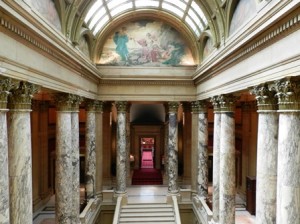 the conversations above and below me as I entered the second floor; it’s considered the “grand” floor of the capitol and it is packed; here are the chambers for the Senate and the House of Representatives, and the Supreme Court. The chambers have been restored to their 1905 look with skylights and original colors and furnishings. Minnesota has 67 senators and 134 representatives; they meet biennially, for a session not exceeding 120 legislative days. A gate across the doorway prevented me from walking in, but allowed
the conversations above and below me as I entered the second floor; it’s considered the “grand” floor of the capitol and it is packed; here are the chambers for the Senate and the House of Representatives, and the Supreme Court. The chambers have been restored to their 1905 look with skylights and original colors and furnishings. Minnesota has 67 senators and 134 representatives; they meet biennially, for a session not exceeding 120 legislative days. A gate across the doorway prevented me from walking in, but allowed 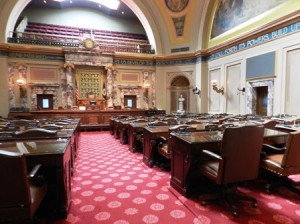 picture taking through the bars. In the Senate I saw the electronic voting boards, and the paintings by Edwin Blashfield; in the House the ceiling is decorated with four names – LaSalle, Hennepin, Perrot, and Duluth – early French explorers in the Northwest. Oral arguments are heard by the chief justice and six associate justices in the Supreme Court chamber, although they are now housed in the Minnesota Judicial Center nearby.
picture taking through the bars. In the Senate I saw the electronic voting boards, and the paintings by Edwin Blashfield; in the House the ceiling is decorated with four names – LaSalle, Hennepin, Perrot, and Duluth – early French explorers in the Northwest. Oral arguments are heard by the chief justice and six associate justices in the Supreme Court chamber, although they are now housed in the Minnesota Judicial Center nearby.
After a stop for postcards at the gift shop desk, and putting my pin on “Alabama” on the visitor’s map, I headed back outside, turning for one last look up at the Quadriga. “So if Cass Gilbert designed the building, supervised the construction, commissioned the art, and commissioned the sculptures,” I thought, “he’s the one who selected the artists for that.” Back in my room, I read up on the Quadriga sculptors Daniel Chester French and Edward Clark Potter. French (1850-1931) is best known for the classic statue of Abraham Lincoln that sits in the Lincoln Memorial in Washington. I found it interesting that he was friends with Ralph Waldo Emerson and the Alcott family; his decision to pursue 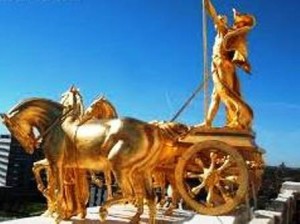 sculpture was influenced by Louisa May Alcott’s sister. I also found it interesting that he designed the Pulitzer Prize gold medal. The awards and honors he received for his work were too numerous to count. Potter (1857-1923) became an assistant to French in 1883 and concentrated on animal studies. He is best known for his equestrian and animal statues; his most famous works are the marble lions that grace the entrance to the New York Public Library. He and French collaborated on many things, in addition to the Quadriga.
sculpture was influenced by Louisa May Alcott’s sister. I also found it interesting that he designed the Pulitzer Prize gold medal. The awards and honors he received for his work were too numerous to count. Potter (1857-1923) became an assistant to French in 1883 and concentrated on animal studies. He is best known for his equestrian and animal statues; his most famous works are the marble lions that grace the entrance to the New York Public Library. He and French collaborated on many things, in addition to the Quadriga.
Too bad I was too chicken to venture out on that balcony today. I wonder if Gilbert and French and Potter climbed out the day the Quadriga was installed, back in 1906. If they did, I can imagine the applause.
Minnesota State Capitol, 75 MLK Boulevard, open daily, call 651-296-2881 about tours http://sites.mnhs.org/historic-sites/minnesota-state-capitol


